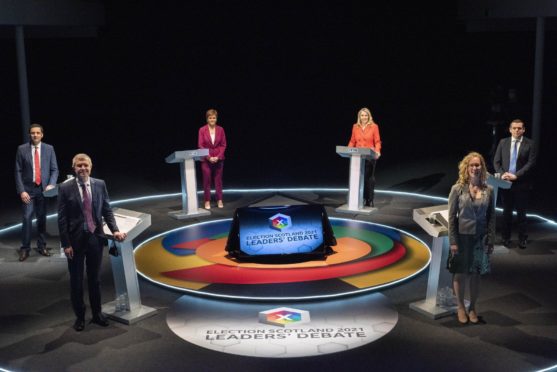There was more distance on the covid-safe stage than there was between their opening pitches.
Each of Scotland’s main political leaders took their first televised opportunities as you’d expect. They all know the pandemic has shaken the country, wiped out jobs and forced us all to live without seeing family and friends in lockdown.
But this being Scotland, there’s always the constitution to split on.
“It’s only nine pages,” Nicola Sturgeon explained to viewers asking why a referendum plan was published in a pandemic.
And they were off – well, some of them. Douglas Ross in particular keen to hammer home a unionist line.
‘Outbreak of consensus’
But there was something different about this leaders debate. The constitution didn’t actually dominate every waking minute. Even when Mr Ross tried to push it back on to independence and the union, the fireworks fizzled out.
If anything, the attempt to force it into every answer jarred with what threatened to be an outbreak of consensus on tackling the big day-to-day issues.
Labour’s Anas Sarwar needed a strong showing on this – he’s only been in the job a few weeks – and he jumped at the chance to cast himself as a constructive voice.
There were pointed jibes between the two men – Mr Ross was told to “grow up” at one point in this mini battle for second place while Ms Sturgeon looked on, happy to let them take the strain.
The Greens’ Lorna Slater is not a household name, but appeared confident in taking on the climate challenge without majoring on her party’s support for independence. Willie Rennie also detects that desire for consensus and played up his experience at Holyrood and Westminster.
The future of our place in the union, or out, was there in the debate, and there’s no doubt it runs like a thread through Scottish politics. However, the health service, education, actual devolved responsibilities, somehow muscled out the Yes/No theatrics.
Even Alex Salmond’s new single issue pro-independence party fell by the wayside. One question on his new Alba group was put to a Yes voter. The answer? Not the constitution, but climate change.
Everyone knows the constitution divides the electorate. But it was clear ordinary Scots – however they’d vote in a referendum – want politicians to put their energies right now on a national recovery, not national division.
